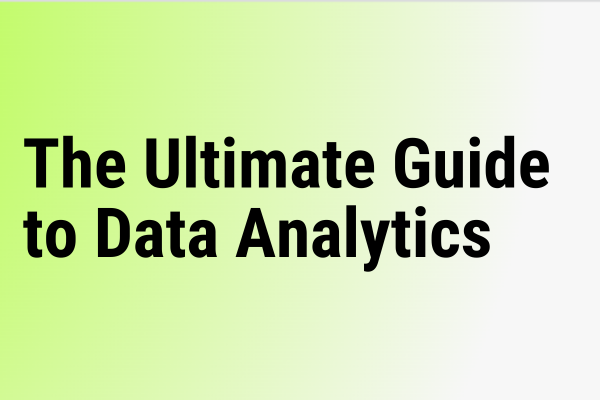
Data is powerful – and organizations around the world understand the value that data analytics hold when it comes to driving organizational growth and profitability.
If you're looking for a career that combines your analytical skills with your passion for problem-solving, a job in data analytics could be your next career move.
Whether you're a recent graduate or looking to make a career switch, this complete guide will talk about the foundational knowledge you need to kickstart your career in data.
Data analytics involves using data, techniques and tools that identify patterns and trends, which in turn generate actionable insights that support informed decision-making. The primary objective of data analytics is to address specific questions or challenges that are relevant to an organization to drive better business outcomes.
In today's business and workforce landscape, making data-informed strategic decisions is crucial. Whether an organization aims to gain a deeper understanding of its consumers, optimize processes or generate new business opportunities, knowing how to leverage data can yield significant benefits.
Organizations utilize data to enhance their internal operations and to gain insights into their customers. This is typically achieved through three stages:
| Data Collection and Storage | Data Processing and Organization | Data Analysis and Visualization |
|---|---|---|
| During the data infrastructure stage, those who are tasked with creating a data infrastructure are responsible for constructing, implementing and maintaining the technology required for collecting and storing data. | Once data is collected and securely stored, qualified IT professionals are needed to design and maintain the flow of data to ensure its accuracy and completeness. | The final stage of data utilization is data interpretation and visualization. Advanced analytics are necessary to collect valuable insights, detect patterns and trends and make informed decisions. This stage is focused on data analytics. The previous two stages typically feature database administration and data engineering. |
The different stages of the data use process are interdependent. From marketing campaigns and sales goals to research and development, a comprehensive data analytics program can benefit the entire organization.
Data analytics provides valuable insights that can be used to enhance processes, products and services. By improving analytics capability, businesses can make better decisions that lead to more efficient operations and improved overall performance.
“Everybody works with data. So regardless of whether you're a data analyst or data scientist, maybe you're a manager, maybe you're an executive, having an understanding of data is really fundamental to being effective. And so, it's just one more tool in your arsenal to make you better at what you do, to make more informed decisions and to be more targeted in your actions,” says Jen Hood, analytics and data governance manager at Zebra Technologies.
With the increasing amount of data available from various sources, such as social media and smart devices, it's more important than ever to prioritize data management and thorough analysis. Plus, a solid understanding of data function, techniques and tools are crucial when developing a comprehensive data analytics strategy.
In addition, data-related jobs are some of the fastest-growing careers, with the demand for professionals who can utilize data to generate better business outcomes increasing each year.
Data analytics offers many benefits to both organizations and data professionals, including:
1. Recognizing patterns and trends
2. Understanding how data is compiled
3. Helping organizations reach their goals
4. Future-proofing their career
5. Helping stakeholders make better decisions
6. Improving productivity
7. Providing imperative information for organizations
8. Identifying and leveraging sources for a competitive advantage
9. Mitigating risk
The tech industry typically recognizes four types of data analytics:
Descriptive analytics provides a current snapshot by identifying trends and patterns of past and current data. It answers questions about what has happened in the past and what is happening now.
Diagnostic analytics focuses on the reasonings behind trends and patterns that are identified in the previous stage, helping to discover the factors for past performance.
Predictive analytics uses techniques like machine learning and forecasting to determine what is likely to happen in the future.
Prescriptive analytics uses machine learning, algorithms and business rules to provide specific solutions and recommendations on what to do next to achieve a desired outcome.
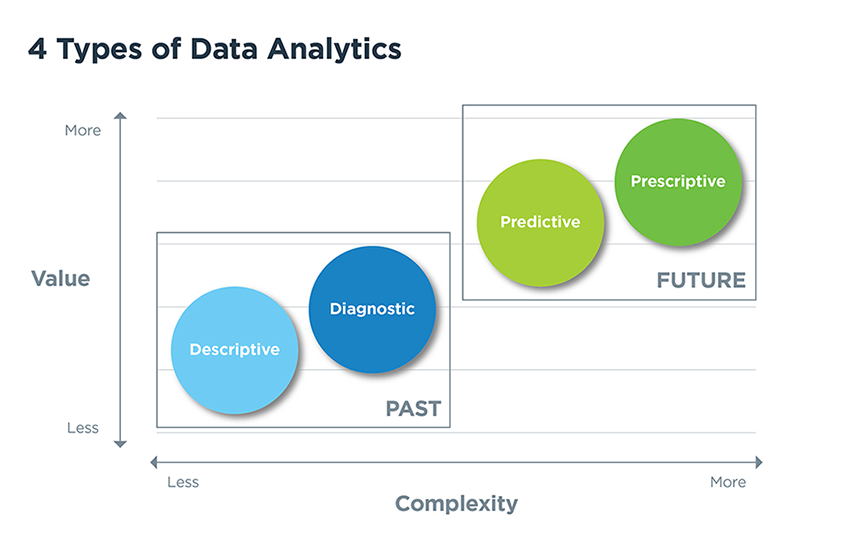
To be successful in your career as a data professional, you need a specific set of skills and qualifications that can be obtained through a formal college degree or through certifications and other training programs.
2.5 million job postings listed in the United States in 2022 show that employers and hiring managers are seeking candidates with data-related skills such as data analysis, data mining and data visualization.
Although the specific skills you need depend on the role you are applying for, data professionals typically possess a combination of the skills below, aggregated from a review of data analyst job postings.
| Technical/Hard Skills | Professional/Soft Skills |
|---|---|
| Understanding of data processes and principles, and ability to apply basic statistical methods | Communication (written and verbal) |
| Data analytics and visualization software | Storytelling and presenting |
| Machine learning algorithms and models | Decision-making |
| Ability to mine, manipulate, analyze, interpret and visualize data | Problem-solving |
| Python, R and other programming languages | Analytical mindset |
| Data optimization | Creative thinking |
| Predictive modeling | Attention to detail |
| Database management | Time management |
| Adherence to governance and quality standards throughout the entire data life cycle | Organizational |
CompTIA data shows that there are nine common challenges involved in strong data management.
With so much data available, collecting and interpreting meaningful data is a big challenge. Analysts may not fully analyze data, or they might only focus on data that are easiest to collect instead of those that add value. This is especially true when it comes to manually analyzing data, which causes delays and renders it impossible to gain real-time insights and provide accurate reports.
Data often comes from multiple sources like social media, websites, email, etc. But consolidating all of this data manually is time-consuming and can limit insights to what is easily viewed.
With a comprehensive and centralized system built to collect data from multiple sources, data professionals will have access to all types of information in one location. Not only does this free up time spent accessing multiple sources, but it also gathers all the relevant data for analysis, providing complete reports with minimal risk of errors.
Managing new data formats requires adapting to diverse and constantly evolving data types, such as unstructured or semi-structured data, which may not fit traditional data processing methods. This necessitates the development or adoption of flexible and scalable data processing and storage solutions to effectively extract valuable insights.
The rapid evolution of data analytics requires a skilled workforce. And the shortage of skilled data professionals can hinder an organization's ability to effectively make business decisions.Organizations can address the shortage of skilled data professionals by investing in training and development, or hiring experts to handle complex data analytics tasks and tools.
Organizations that store large volumes of data tend to be targets for cyberattacks, and data professionals are responsible for keeping data security at the top of their priorities.
Regular maintenance checks might be difficult to keep up given the amount of data, so it’s important to have the proper security guidelines in place to minimize the risks of potential attacks as much as possible.
Building proper networking architecture requires designing a scalable and secure infrastructure that can handle the efficient flow of data, communication and resource sharing within an organization. Additionally, maintaining optimal network performance is crucial for seamless data processing and analytics operations, further complicating the design process.
Increased manual effort, long processing times and a higher likelihood of errors affects the quality and reliability of data insights. Incorporating automation in data processes can improve an organization's ability to scale its data analytics capabilities, improving its potential to derive value from growing data volumes.
Building a proper storage architecture requires balancing the need for high-performance data access, cost-effective storage solutions and efficient data management while ensuring data security and scalability to accommodate growing data volumes and evolving analytics requirements.
Being able to easily access information should be the simplest part of data analytics, but security and compliance issues are making it harder for analysts to access datasets.
Data collected can only benefit the business if accessible to the right people, and decision-makers and data teams need access to an organization’s data for insights on what is happening in real-time.
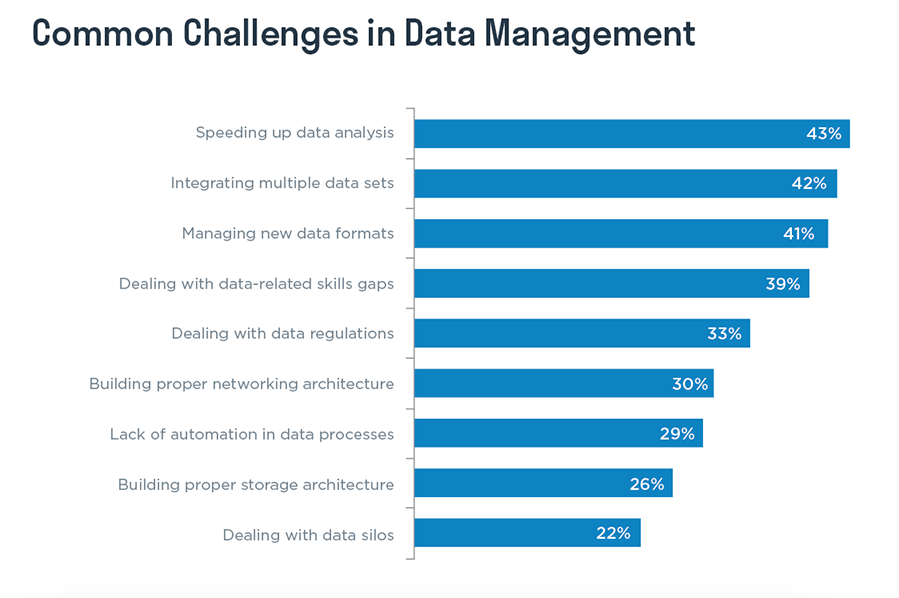
As the importance of data grows, more job roles are required to better communicate vital business intelligence. Data is a broad field that encompasses a variety of different career paths, including those that are not data-specific roles, and it’s important to note that specific job titles may vary depending on the organization.
There are two primary pathways in the field of data—the interpret data path and the manage data path. Let’s take a look at the roles that fall under each pathway.
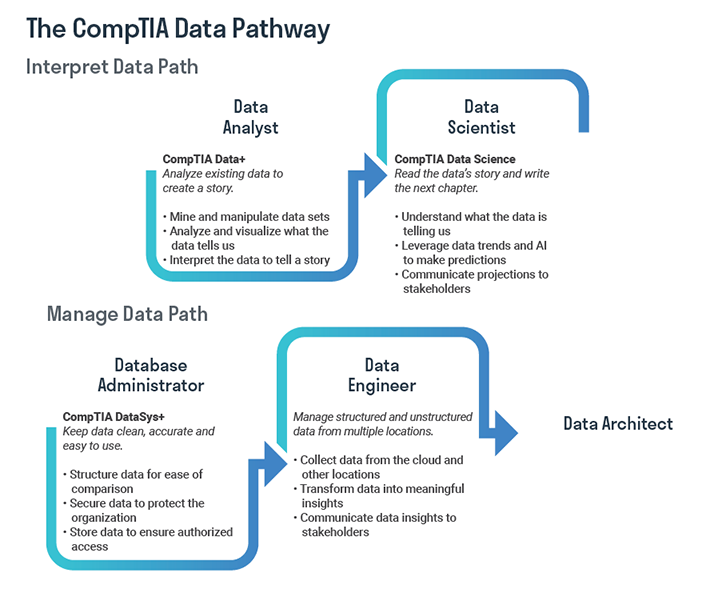
Data analysts leverage insights from multiple data sources to solve certain problems or answer questions, as well as recommend different methods and techniques that can help improve data systems and processes and help key members of the organization make informed decisions.
A data analyst supports their organization in the following ways:
According to BLS, the median salary for a data analyst is $95,270 per year – 108% higher than the median national wage.
A data scientist uses algorithms and statistical modeling to extract information and insights from data to make decisions. They must also have a keen eye for detail to vet the data and identify mistakes made during collection.
A data scientist supports their organization in the following ways:
According to BLS, the median salary for a data scientist is $100,910 per year – 121% higher than the median national wage.
Database administrators build the foundation for data activity by managing database structures. They manage and update all aspects of an organized database environment as well as develop database-related policies for maintenance, security and system usage.
A database administrator supports their organization in the following ways:
According to the U.S. Bureau of Labor Statistics (BLS), the median salary for a database administrator is $96,710 per year – 111% higher than the median national wage.
Data engineers focus on the handling of data—organizing, cleaning, storing and making databases accessible. They typically coordinate with those using the data, such as executives and data scientists.
A data engineer supports their organization in the following ways:
According to Lightcast, the median salary for a data engineer is $110,640 per year.
Data architects translate business requirements into technical specifications and are responsible for designing, implementing and maintaining the blueprint that informs the organization’s enterprise data management framework.
After evaluating an organization’s potential data sources, a data architect designs a plan to integrate, centralize, protect and maintain them in the following ways:
According to BLS, the median salary for a database architect is $123,430 per year – 170% higher than the median national wage.
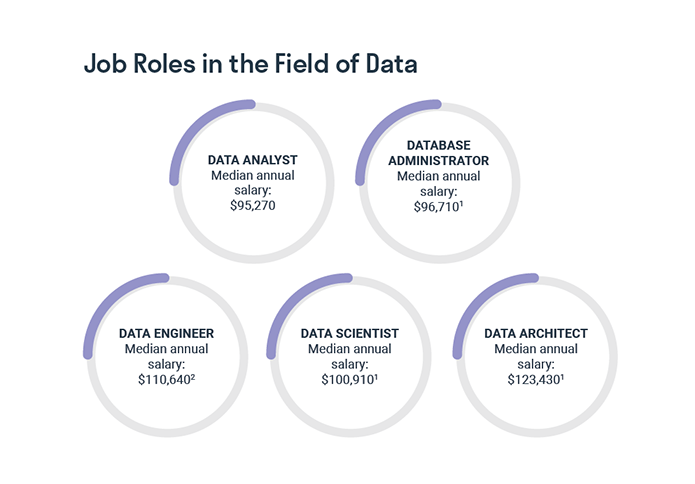
Wondering how much you could make? Check out the CompTIA IT Salary Calculator.
It’s important to note that many factors influence salary, such as location, job level, years of experience, specialty skills, industry sector, employer size and more.
It’s no surprise that data is paramount across every industry, not just tech. Data professionals collaborate with different teams to determine organizational goals and needs, then they gather, analyze and report on their findings.
Let’s take a look at the various industries you can specialize in as a data professional.
Tech leaders worldwide all leverage strong data analytics teams to continuously make business improvements.
For example, analytics can highlight which software functions users like and where they may be having difficulties.
In the past, organizations had to rely on time-consuming methods like surveys to identify buying patterns, shopping preferences and other customer behaviors. Now, data provides marketers insight into what consumers want to purchase as well as ways to improve cross-selling and upselling.
To cater to the needs of an organization’s target audience, it’s necessary to keep up with traffic, engagement and trends as well as to keep a pulse on user data to help make better decisions and serve customers with the products and services they are looking for.
If you work as a marketing analyst, you might use data to assess the effectiveness of past campaigns and determine which strategies to replicate or change to ensure high-performance for future campaigns.
In recent years, data professionals have become a key in transforming financial data into business insights not only to support stakeholders make better decisions, but to also allow for a deeper understanding of metrics and key performance indicators (KPIs), appropriate examination of financial transactions and predictive forecasting.
If you work in the finance industry, you might use data analytics to make sense of large amounts of raw data when managing fund allocations or to detect potential fraudulent purchases.
Whether it’s life, car, health or home insurance, data analytics is needed for organizations to improve processes, generate leads and increase customer retention as well as analyze a customer’s risk and detect potential fraud.
In the healthcare industry, data analytics have been pivotal when it comes to improving patient outcomes, identifying patterns and anomalies in patient history, and predicting potential widespread illness and outbreak areas. Insights like this help predict future needs, which can result in proper funding and improved diagnostic techniques.
If you work as a clinical analyst, your day-to-day might involve collecting data from clinical trials and ensuring that the data is accurate and reliable.
Data analytics guide decisions around how to create production schedules, allocate resources, set prices and manage supply chains. Data professionals in the manufacturing industry also leverage data to better plan workloads to allow for machines to operate closer to peak capacity.
Data professionals make use of operational systems and machine data to meet goals such as:
Skilled data professionals have the ability to unlock successful and diverse career paths.
And with the rise of remote and hybrid work, aspiring tech pros can look to data analytics as a potential career path that provides flexibility, independence, more job opportunities, better work/life balance and less commute stress.
According to the CompTIA State of the Tech Workforce report, tech occupation employment over the next decade is expected to grow at about twice the rate of overall employment across the economy, with a 266% projected tech growth rate above the national rate for data scientists and data analysts.
Data analytics is a major factor driving the future of technology, and it’s all around us. We even utilize predictive analysis in our homes. Devices like fitness trackers, smart appliances and home assistants collect meaningful user data points to predict behavior and further advance automation capabilities.
There are multiple paths toward securing your first job in data analytics. Whether you’re just getting started in the professional world or pivoting to a new career, you can be sure to find data analytics jobs no matter the industry. Let’s take a look at some actionable steps, tips and courses you can explore to start your career in data.
Data analytics is a career path that requires you to have strategic analysis, critical thinking and technical skills, while also having focus, determination, and strong communication and business skills to interpret complex datasets day in and day out.
As you research potential data jobs, consider the following questions to help you determine if a data analytics career is right for you:
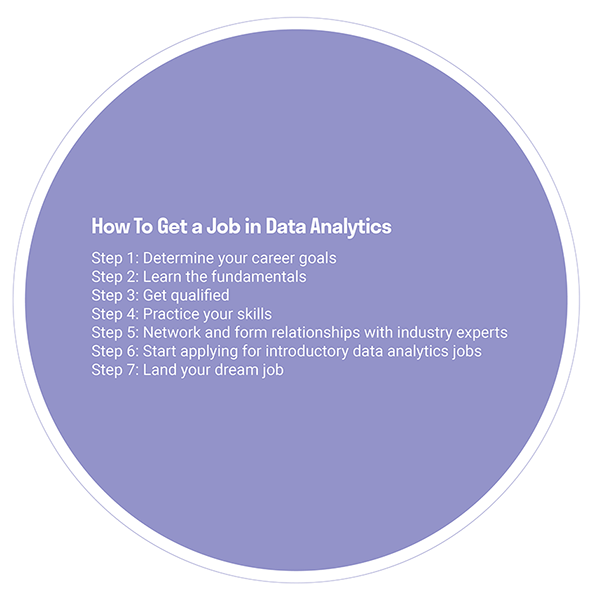
While studying and researching different job opportunities, start defining your short- and long-term career goals to help narrow down opportunities to those that best suit your desired career path. You can also take this time to develop your specialization or niche, which will help give you a competitive edge in the job market.
“There are so many different niches within data analytics,” Hood says. “It's part of what I love about the field. At the heart of it, you're solving problems and working with data, but the tools you use can be radically different depending on the industry that you're in.”
It doesn’t matter if you decide to pursue a degree or validate your skills and knowledge through certifications, there’s one thing for certain: You need to learn the fundamentals.
If you haven’t already, you’ll want to start by developing some foundational data process knowledge, such as how data works in a business setting and how to use the tools you will need to interpret it. Getting a broad overview of data analytics can also help you decide whether a career in data analytics is right for you.
Remember that everyone learns in different ways. Some prefer self-study programs with online tools and books while others succeed with instructor-led training – and many can benefit from both.
While you can learn fundamental knowledge and enhance your resume with a degree in an analytical field, such as statistics, math, computer science, economics, data science or another related field, you can also complete certification programs, bootcamps or self-study courses to prove your skills.
Standing out from the competition in a popular and lucrative field like data analytics can be difficult. So, if you already have a degree, earning certifications is a great way to capture the attention of recruiters and hiring managers.
Once you’re qualified and have the basics under your belt, you can begin practicing and further developing your skills.
One way to practice your data analytics skills is through real-world, hands-on experience. Many degree programs or courses allow you to work on projects with real datasets, or you can find free and public datasets that you can use.
When it comes to deciding what projects to work on, make sure you pick a topic that you’re interested in, ask a question about it and try to solve that question with data. This is a great way to demonstrate your abilities to potential hiring managers.
Remember, many employers will be looking for a balanced combination of technical skills and relevant soft skills, so don’t forget to strengthen your professional skills just as much as your technical knowledge.
Establishing relationships with industry veterans and building your list of networking contacts who are ready to share their experiences is crucial when kickstarting or advancing your career. They might give you inside information of what’s happening in your field of interest, provide mentorship support and, most importantly, help you land your dream job.
Here are a few ways you can start networking:
After gaining some hands-on experience and determining what role you want to pursue, the next step is to refine your resume. After all, the first impression that recruiters have of you is through your resume.
Make sure that you follow these tips to perfect your resume:
After you polish your resume, it’s time to begin applying for entry-level data jobs. Apply to positions that you are interested in, even for jobs that you don’t feel 100% qualified for. Your skills, portfolio and eagerness are often times more important than checking off every bullet in the job description.
Certification programs and courses are excellent ways to improve your chances of getting your first data analytics job or qualifying for more advanced positions at higher salary levels, and it pays to choose the one that is best suitable for your career goals. Here’s a current sampling of some of the most popular data analytics certifications.
Compared to other professional certificates and certifications, CompTIA Data+ is the only entry-level, vendor-neutral, hands-on analytics certification on the market designed for professionals tasked with developing and promoting data-driven business decision-making. This certification is a good starting point for those choosing to specialize in data analysis, but Data+ is also a great choice for those that use data regularly but are not specialized on data. The topics you learn validates the knowledge, skills and abilities you need to start and advance your career in data.
CompTIA Data+ proves to employers that you have the data skills needed to meet organizational goals such as:
Is CompTIA Data+ right for you? Click here learn about what it covers, the job roles it aligns to, how you train and more.
Additionally, CompTIA Data+ trains you to adhere to oversight and data quality standards, as well as comprehend the following:
Ready to start studying for CompTIA Data+? Click here to download the exam objectives.
The Google Data Analytics Professional Certificate by Coursera covers key information that you need to find an entry-level data analytics job, such as data structures, how to analyze data, data storytelling and using R programming to supercharge your analysis.
The IBM Data Science Professional Certificate is for beginners who want to kickstart their career in data science. This program consists of nine courses that cover SQL, Python, data science, machine learning algorithms and statistical analysis, data visualization and more.
AWS Certified Data Analytics is designed for individuals with experience working with common data analytics technologies and AWS services to design, build, secure and maintain analytics solutions. This exam validates a candidate’s ability to define AWS data analytics services and understand how they integrate with each other as well as how they fit in the data lifecycle of collection, storage, processing and visualization.
SAS Certified Big Data Professional enables you to work with Hadoop, one of the best open-source tools for storing large volumes of data. It is helpful to those working with big data and it enables data professionals to run applications on clusters of commodity hardware.
Microsoft Certified: Power BI Data Analyst Associate enables individuals to transform data, create scalable data models, visualize data and share assets by using Microsoft Power BI. It also provides candidates with the skills necessary for cleaning and transforming data.
Certified Analytics Professional (CAP) is an advanced analytics certification designed for those seeking to be proficient in business problem framing, analytics problem framing and methodology selection. Model building, deployment and lifecycle management are other skills certified individuals possess.
Cloudera Certified Associate (CCA) Data Analyst enables data professionals to pull and generate reports in the Cloudera CDH environment using Impala and Hive. Individuals who earn the CCA Data Analyst credential also have expertise in providing structure to data and using query language statements in Impala and Hive to analyze data on the cluster.
The amount of time it will take to become certified in data analytics depends on your knowledge and experience.
For CompTIA Data+ there are no official prerequisites, but we recommend 18 to 24 months of experience in a report/business analyst job role or sufficient training in foundational areas like statistics and data visualization. We also suggest that you dedicate between 30 and 40 hours of studying before sitting for the exam. If you don’t have at least 18 months of work experience, you can still earn CompTIA Data+, but you might need to train more rigorously than someone with on-the-job experience.
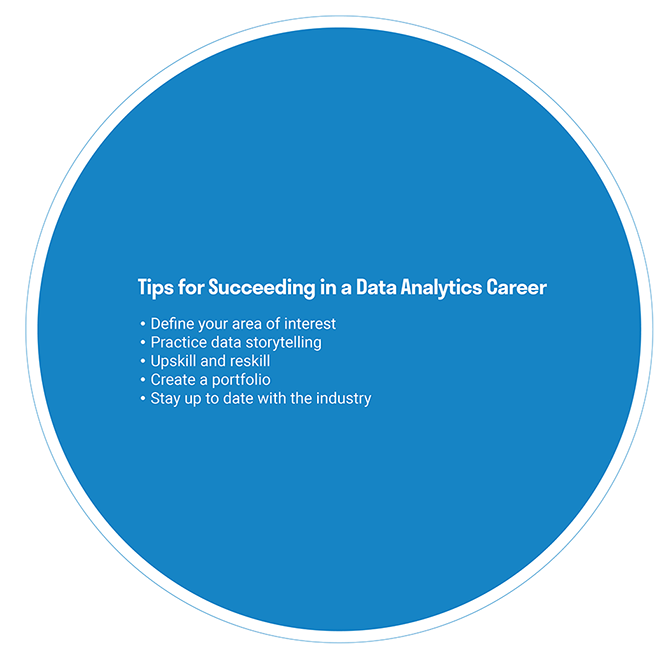
You’ve finally landed a role as a data analyst. Now what?
Although it’s crucial to learn the fundamentals, the data subject is broad, and it’s easy to feel like you have to understand everything from start. But it's valuable to define an area of expertise or interest and hone those skills.
For example, if you are naturally adept at problem-solving, you might specialize in operations-related data analytics. If you’re interested in using data to identify trends, you might specialize in statistical analysis.
It can be easy to focus on the technical aspects of data analytics, but being able to effectively communicate your findings to decision makers and other stakeholders is an important part of working in an analytics role.
Data needs to be presented in a format that facilitates comprehension, and to provide a powerful narrative to your insights, data often needs to be presented in graphs, charts and other visuals.
When you’re able to tell an impactful story with the data, it’s easier to help your organization facilitate data-driven decisions. If you are unable to explain how your findings will affect the performance of the organization, then the solution is unlikely to be executed.
"One of the biggest things you can do to set yourself apart from other candidates is being able to relate to the business and not just talk about technical skills,” Hood said.
The field of data is ever-changing, and as organizations leverage data to improve operations and better understand consumers, more data professionals with new and improved skills are needed to drive success.
Upskilling is the process of learning new skills to enhance your skill set, while reskilling is the process of replacing outdated skills with ones that meets the needs of the changing market – especially with organizations prioritizing on closing the data skills gap.
You can upskill and reskill through courses and certifications, and there are various ways to prepare for your exam.
CompTIA has a full suite of training products to help you learn and practice the skills you need to prepare and pass your certification exam:
No matter how you choose to sharpen your skills, choosing a variety of study tools to absorb information from every angle is a great way stay ahead of the curve.
As you complete projects or hands-on assignments in your classes, be sure to add your work to your portfolio. A strong, high-impact portfolio is highly valued and demonstrates your ability, creativity and individualism to hiring managers. Plus, it can go a long way toward standing out from the competition and getting the job – especially if you are lacking in formal education or experience.
As you start to work on your portfolio, choose projects that showcase your ability to:
Technology is advancing faster than ever before, so staying up to date with data and analytics trends will allow you to anticipate change and manage uncertainty.
Understanding what tools are available, how to use them and how each one can help you meet business objectives is crucial when starting your career as an analyst.
| Tool | Description |
|---|---|
| Structured Query Language (SQL) | A special-purpose programming language used for managing and manipulating relational databases. |
| NoSQL Database | A database management system that does not rely on a traditional relational database structure, often used for handling unstructured or semi-structured data. |
| Python | A general-purpose programming language with extensive libraries and frameworks that enable data analysis, machine learning and visualization. |
| Microsoft Excel | A simple, but powerful spreadsheet program commonly used for data entry, basic data analysis and visualization. |
| R Programming | A programming language commonly used for statistical computing and graphics. |
| Tableau | A data visualization software that allows for visualization, analysis and understanding of data. |
| SAS | A software suite for advanced analytics, multivariate analysis, business intelligence, data management and predictive analytics. |
| Power BI | A business analytics service provided by Microsoft that offers interactive visualizations and business intelligence capabilities. |
| AWS/Amazon Web Services | A cloud-based platform offering a variety of services and tools for storage, computing, analytics and machine learning. |
| Hadoop Ecosystem | An open-source software framework used for collecting and processing large amounts of data. |
| In-Memory Database | A database management system that stores data in memory to achieve faster processing speeds. |
| Apache Spark | An open-source data processing engine that provides faster and more efficient processing of large datasets. |
| Data Lake/Data Warehouse | A centralized repository that allows for the storage of unstructured and structured data at any scale. |
| Google Analytics | A web analytics service offered by Google that tracks website traffic and provides insights into user behavior. |
| Term | Definition |
|---|---|
| Ad-hoc report | Reports that are generated on request. |
| Aggregation | Process of collecting data to present it in summary form. |
| Algorithm | A set of heuristics and calculations that creates a model from data. |
| Analysis | The process of analyzing the past or future and making an informed decision. |
| Artificial intelligence (AI) | Computer systems that are able to perform tasks that normally require human intelligence. |
| Business intelligence (BI) | Process of using strategies and technologies to analyze business information and transforming it into actionable recommendations for key stakeholders. |
| Cloud | A virtual space that allows users to access to storage, files, software and servers through internet-connected devices. |
| Cluster analysis | Grouping objects in a way that objects in the same cluster are more similar to each other than they are to objects in a different cluster. |
| Data | Facts and statistics collected together for reference or analysis. |
| Data analytics | The science of analyzing raw data to make conclusions about that information. |
| Data mining | Process used to extract usable data from a large dataset. Data mining involves data collection, warehousing and computer processing. In order to segment and evaluate the data, data mining uses advanced algorithms. |
| Data modeling | The process of diagramming data flows. |
| Data visualization | Data visualization presents a clear picture of what the data actually means. Using bar graphs, pie charts, tables and other visuals, data visualization makes the data easier for those making business decisions to comprehend. |
| Mean | Average of all of the numbers in a dataset. |
| Median | The middle number in a dataset (when in order). |
| Mode | The most common number in a dataset. |
| Querying | Requesting data from a database. |
| Recurring reports | Reports that are compiled and presented on a regular, ongoing basis. Examples:
|
| Regression analysis | A statistical method used to measure the relationship between variables. |
| Standard deviation | A measure of how dispersed the data is in relation to the mean. |
| Structured data | Standardized, clearly defined and searchable data. |
| Text analytics | The process of drawing meaning out of written communication. Usually, text analytics software relies on text mining and natural language processing (NLP) algorithms to find patterns and meaning. |
| Unstructured data | Datasets (typical large collections of files) that aren't stored in a structured database format. |
| Values | Information that has been translated into letters, numbers, and/or symbols so that it can be read, moved and manipulated by a machine. |
Ready to get your data analytics career started? Sign up for a free 30-day trial of CompTIA CertMaster Learn + Labs to gain the knowledge and practical skills necessary to be successful on your CompTIA Data+ certification exam.
Download CompTIA’s free Ultimate Guide to Data Analytics and discover everything you need to know to get started on your data career today.
Download the GuideRead more about IT Career Center, Data and Analytics.
Tags : IT Career Center, Data and Analytics